Atopic Dermatitis + Skin Allergies in Dogs: Pictures, Causes + Solutions
Remember, this is an educational resource, not a guide for diagnosis.
Pictures are helpful, but they may not tell the whole dermatological story. We always recommend consulting with your vet for any of your dog's health concerns.
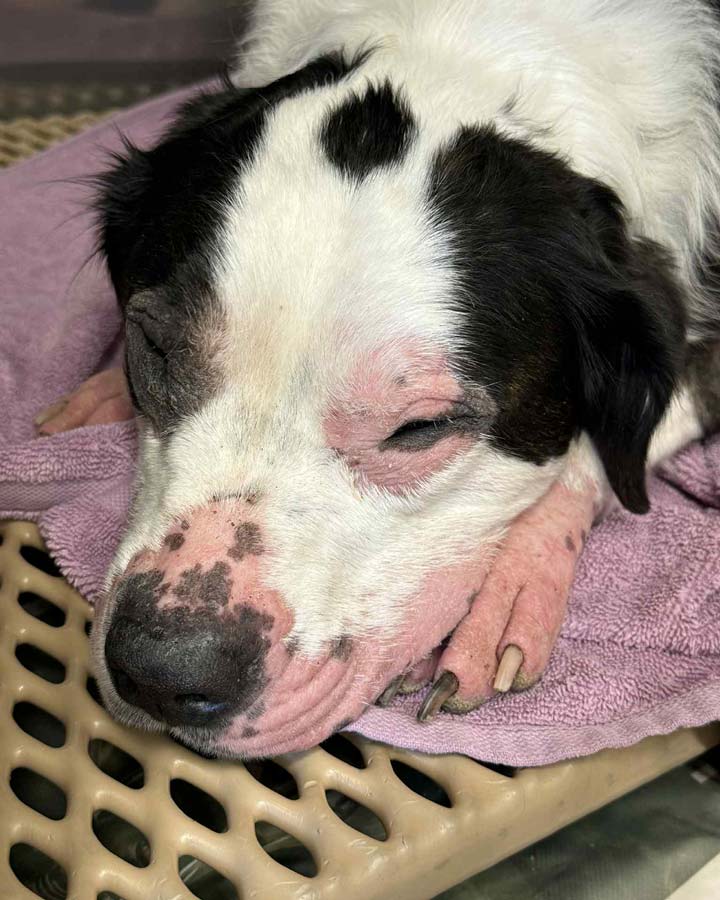
What Is Canine Atopic Dermatitis?
Canine atopic dermatitis, also known as atopy or eczema, is an allergy-caused skin condition that creates inflammation and chronic, excessive itching (pruritis) in various parts of the body. It can be a seasonal or perennial (all-year) skin condition.
This "big itch" leads to redness (erythema), rash, self-inflicted hair loss (alopecia), pustules - and over time - wounds, hot spots, darkened skin patches (hyperpigmentation), and hardened, scaly skin (lichenification).
Atopic dermatitis is a lifelong condition that is believed to affect 10-15% of the dog population. Unfortunately, there is no cure, but atopy can be managed effectively with proper treatment that is unique to each dog.
Photo: Atopic dermatitis with missing fur on face and feet; via Family Pet Clinic
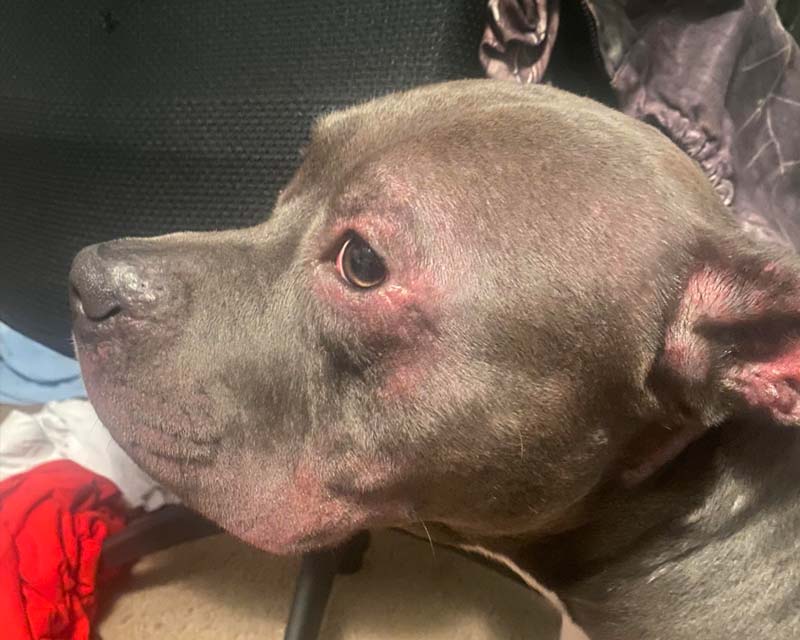
What Causes Allergies and Atopic Dermatitis in Dogs?
To put it simply, atopic dermatitis is caused by a reaction to an allergen that is initialized by the dog's immune system. Allergens come in a plethora of forms and can be seasonal, environmental, or food-related.
When allergens gain entry via a damaged or defective skin barrier, the immune system triggers a response that sends an array of different cells to an area of the skin, creating inflammation.
Unfortunately, the immune system's mechanism for determining what it considers a threatening "allergen" is not fully understood - neither in dogs or humans. In essence, we don't know why it "hates" one substance and tolerates another.
What we do know is that this inflammation and the cells' activity creates a powerful itching sensation and tends to affect specific areas of the body.
Photo: Atopic dermatitis around eyes, muzzle, and ears; via r/JDFlamingo14 on Reddit
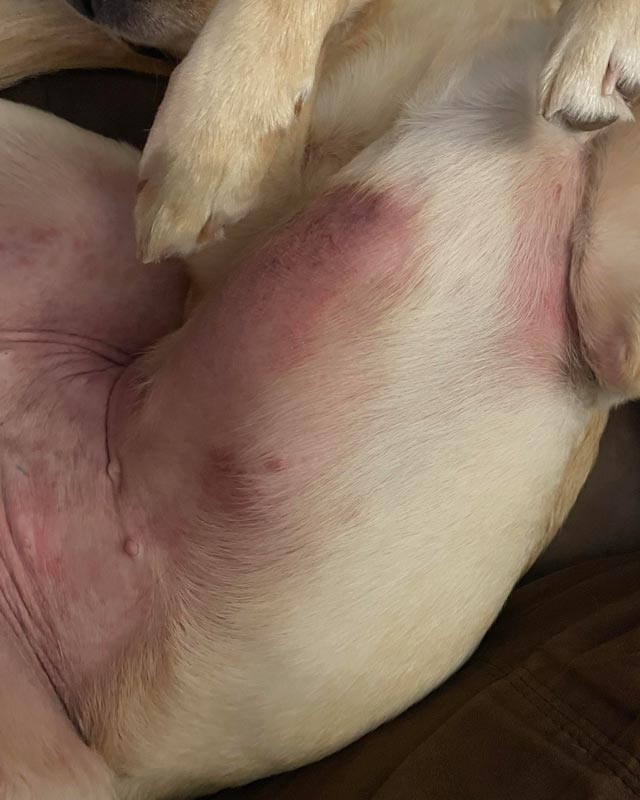
What Parts of the Body Does Atopic Dermatitis Affect in Dogs?
Canine atopic dermatitis appears most frequently in these parts of the body:
- Face, especially around the eyes and muzzle
- Ears, both the external part (the pinnae) and the ear canals
- Feet and paws
- Armpits (axillae)
- Belly (ventrum)
- Groin and hips
- Anus
- Base of the tail
Along with noticeable itch, a general redness often shows itself in these locations.
Photo: Atopic dermatitis with redness and rash on dog's belly and armpits; via r/AlternativeAd7703 on Reddit
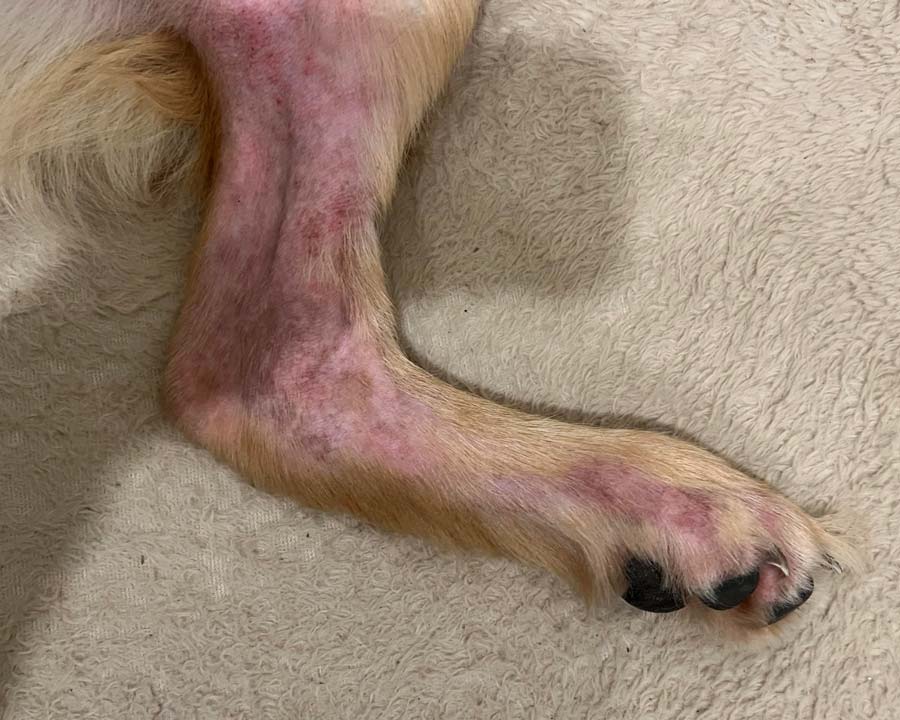
What Allergens Tend to Cause Atopic Dermatitis in Dogs?
Seasonal and environmental allergies account for the majority of canine atopic/allergy dermatitis cases. The most common allergens behind canine atopic dermatitis are:
- Pollen, via trees, weeds, or grass
- Mold
- Dust mites
- Grass and hay
- Dander (dead skin) - which can even include human dander
Along with these allergens, it's also important to determine if flea allergies (an uncommon hypersensitivity to flea saliva), food allergies, demodectic or sarcoptic mange mites, Cheyletiella (walking dandruff) mites, or ringworm are present, as they can also trigger dermatitis and similar symptoms.
Photo: Atopic dermatitis with discoloration and fur loss on dog's hind leg; via r/Glittering_Rush5111 on Reddit
Key Identifiers of Atopic Dermatitis
- Excessive itching, may vary in intensity during different times of the year
- Scratching behind elbows
- Licking and chewing feet
- Rubbing face
- Booty scooting
- Excessive tears and red eyes (often a general sign of seasonal allergies)
- Regular sneezing
As scratching and aggravation continue:
- General redness around area
- Rash with blisters
- Hair loss (alopecia)
- Discoloration and darkening of skin (hyperpigmentation)
- Scaling and hardening of the skin (lichenification)
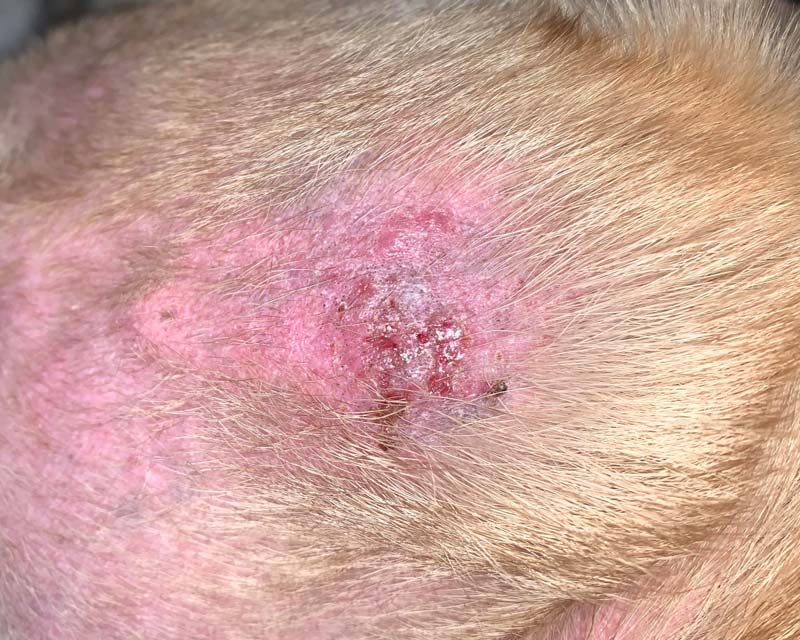
Skin Conditions Associated with Canine Atopic Dermatitis
Due to the strain on the immune system and the constant aggravation of the skin, dogs with skin allergies and atopic dermatitis are also susceptible to contracting other skin problems.
Four of the primary correlated conditions are listed below. Each is linked to another Resource page with more info and photo examples - for the autodidacts in the audience.
- Acute moist dermatitis (hot spots)
- Pyoderma (bacterial infection)
- Malassezia dermatitis (yeast infection of the skin)
- Otitis (ear infection)
Photo: Atopic dermatitis with broken skin lesion, with possible early-stage infection
Dog Breeds Prone to Skin Allergies and Atopic Dermatitis
While genetics do play a role in atopic dermatitis and skin allergies, researchers have not yet been able to identify any definitive genes or genetic markers which would indicate: "Yeah, this dog is definitely going to have these specific allergies and atopic dermatitis."
That said, population studies tell us that skin allergies and atopic dermatitis do tend to be more prevalent in certain breeds, such as:

How Is Canine Atopic Dermatitis Diagnosed?
To date, there is not a specific, definitive diagnostic test for canine atopic dermatitis.
Diagnosis is presumed based upon multiple factors:
- Client history
- Physical examination
- Age of onset, being < 3 years
- Breed or familial disposition to atopy
- Seasonality of clinical signs
- Itch, with no lesions at onset
- Regionality of itch and redness
- Exclusion of other conditions (e.g., fleas, mange mites, Cheyletiella mites, autoimmune disorder, lymphoma, etc.)
- Predominantly indoor lifestyle (see one of our FAQs for more on this)
- Successful response to atopy treatments, such as corticosteroids (glucocorticoids)
- Chronic or recurrent ear infection (otitis), bacterial infection (pyoderma), and/or yeast dermatitis (Malassezia).
Photo: Rash with redness on dog's hips and belly, likely due to allergies; via r/Alarmed_Newt4258 on Reddit (blur added for modesty's sake)
How Is Atopic Dermatitis in Dogs Treated?
As with diagnosis, treating atopic dermatitis in dogs requires a multifaceted approach. There is no cure, nor is there a one-size-fits-all solution for all dogs.
The key to treating and managing canine skin allergies and atopy involves:
- Identifying flare factors (allergens, or what is causing the reaction) and, if possible, reducing exposure to them.
- Reducing inflammation and pruritis (itching) via topical and/or systemic treatment
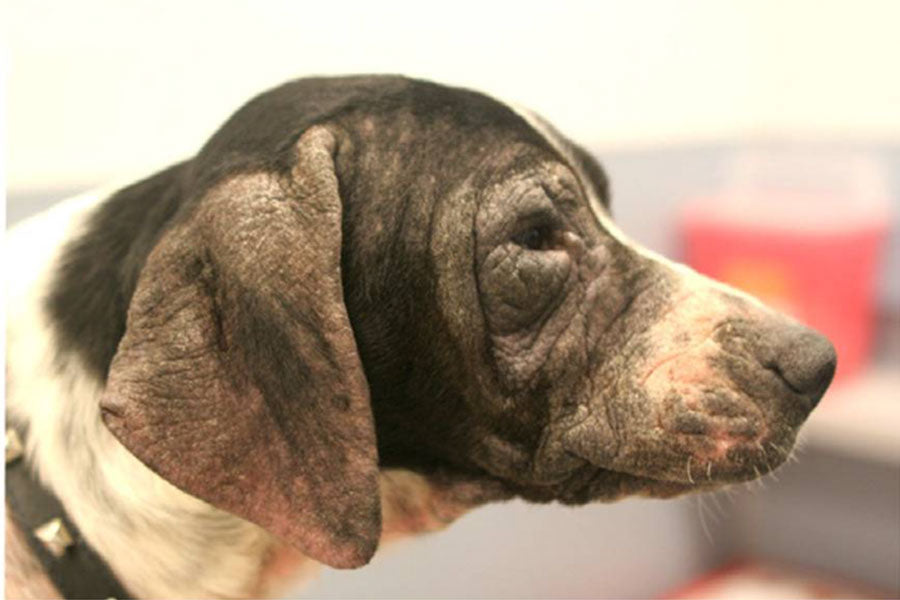
Identifying and Managing Your Dog's Allergies and Flare Factors
"Flare factor" is a fancy phrase for "what fires up your dog's immune system" - in many ways, it is synonymous with "allergens."
Along with the common seasonal allergens listed earlier, some flare factors to consider for dogs with atopic dermatitis include fleabite hypersensitivity (reaction to flea saliva), the overgrowth of Staph bacteria and/or Malassezia yeast, and food allergens (see our Complete Guide to Food Allergies in Dogs for more on that).
Photo: Fur loss with leathery skin (lichenification) on ears and face due to continuous scratching of atopic dermatitis; by the William R. Pritchard Veterinary Medical Teaching Hospital at U.C. Davis, sourced via PubMed Central

Managing Bacterial or Yeast Overgrowth
Dogs with atopy are more prone to suffer from bacterial (pyoderma) and yeast (Malassezia) infections in the skin.
Nearly all bacterial skin infections in dogs are caused by a single species: Staphylococcus pseudintermedius (a cousin to Staph aureus that affects humans). Likewise, the vast majority of yeast infections are caused by a single fungus: Malassezia pachydermatis.
Interestingly, research has shown that atopic dogs have less variance in the species of bacteria and yeast that dwell on their skin compared to non-atopic dogs.
In other words, there's an abundance of Staph and Malassezia compared to other species, which makes these infections far more likely since there are fewer other competing microbes in the microbiome to keep these two in check.
Because of this, it is recommended that dogs with chronic atopic dermatitis be treated 1-2 times per week with antimicrobial shampoos and ear cleansers for the sake of long-term management of secondary infection.
See our Pyoderma Resource and Yeast Resource for more info on these skin conditions, their appearance, and how they are diagnosed and treated.
Photo: Atopic dermatitis on dog belly and hips, with likely bacterial or yeast infection present; via r/mgarland0922 on Reddit

Allergen Specific Immunotherapy
Allergen-specific immunotherapy (ASIT) is currently considered the "gold standard" for treating allergies and atopic dermatitis by veterinary and human dermatologists.
ASIT involves altering the immune response by incrementally administering doses of allergens to which a dog is sensitive. This desensitizing procedure attempts to increase the dog's tolerance to these allergens, slowly increasing the dose until a "maintenance level" is reached.
These doses of allergens can be given either orally or via injections. How often they are given depends on the dog's response.
ASIT does require time - at least 12 months of trial before evaluating the overall effectiveness - but the success rate is said to be approximately 66%.
During administration, patients will still generally require regular bathing, fatty-acid supplementation, and antihistamines.
Photo: Atopic dermatitis on dog paw (pododermatitis) with general redness and fur loss due to allergies; via customer

Managing Itch and Inflammation Due to Atopic Dermatitis
The other, more immediate part of treating atopic dermatitis in dogs is dealing with the inflammation and insufferable itch. The more dogs itch, the more damage they do to themselves, the more likely an infection develops (meaning systemic problems, PLUS more itch), and the more difficult and expensive it is to get things under control.
Here's a general arsenal of what's available in getting itch and angst under control. We'll go into some more detail in the FAQ section further down.
- Spot-treatment topicals - Creams, sprays, and ointments, such as our product Lavengel®. These are ideal for smaller areas and can be a big help in keeping an itchy spot from growing while preventing infection.
- Bathing topicals - Antimicrobial shampoos and mousses cover more area and are likely necessary for lifelong management of canine atopic dermatitis.
- Glucocorticoids - A type of fast-acting topical, oral, or injected steroid that reduces inflammatory response - not ideal for prolonged use.
- Cyclosporine (CsA) - An immune modulator that inhibits an enzyme involved in inflammation. CsA is typically used for long-term management and not for acute flare-ups.
- Oclacitinib (Apoquel®) - A janus kinase (JAK) inhibitor. JAK enzymes are involved in signaling messenger cells that call for inflammation and itch sensors.
- Lokivetmab (Cytopoint®) - An injected monoclonal antibody that binds to and inhibits a specific messenger cell (IL-31) known to induce itch during immune response.
Photo: Missing fur, hyperpigmentation, and acute moist dermatitis, possibly due to parasites or allergy-induced trauma; via r/TheMrDanggas on Reddit
Canine Atopy + Skin Allergies FAQs
What is dermatitis and why is it itchy?
Dermatitis refers to inflammation of the skin. Inflammation is the immune system's response to a threat (such as an allergen), which involves sending an army of different cells to an area of the body to fight the 'invaders' and fix the problem.
Why the Itch? Short Answer
Simply put, this influx of "helper" cells and their processes within the area create an itching sensation, which leads to the itching, scratching, redness, and self-inflicted skin trauma.
The Longer Answer, According to Research
To get more specific, these immune cells - T cells, dendritic cells, eosinophils, and mast cells - produce proteins such as:
- Antibodies (immunoglobulins), which are proteins that identify and neutralize pathogens and foreign substances.
- Cytokines, a substance secreted by immune cells to interact with other cells.
- Interleukins, a type of cytokine, which are messenger proteins that help regulate immune and inflammatory response by communicating between different cells.
- Enzymes, such as janus kinases (JAKs), which play a role in signaling cytokines.
Immunoglobulin (Ig)
Immunoglobulin, especially immunoglobulin E (IgE), determines what the body considers a harmful foreign substance - or in IgE's case, an allergen.
In dogs with canine atopic dermatitis (CAD), allergen-specific IgE can bind to other cells and "tell them" to produce substances that bring about inflammation and itch. High levels of IgE in the blood serum generally indicate an allergic reaction has occurred.
Interleukins (IL)
For dogs with CAD, a specific immune response signals an increased level of interleukin (IL). Interleukin has several forms, identified by number. Certain forms, including, IL-4, IL-13, and IL-31, play a direct role in activating itch-sensing neurons that call for - you guessed it - the itching sensation.
For reference, the treatment lokivetmab (commercially known as Cytopoint®) binds to IL-31 and neutralizes it, helping with overall itch in many dogs.
Janus Kinases (JAKs)
Like interleukins, JAK enzymes are involved in signaling between cells, though primarily in dealing with allergy. JAKs, like JAK1, can work to increase the activity of interleukins (i.e., more itch).
For reference, the treatment oclacitinib (commercially known as Apoquel®) inhibits JAK1, which affects the signaling of the interleukins IL-2, IL-4, IL-13, and IL-31, helping to reduce itch and inflammation.
How all of these cells, proteins, antibodies, and enzymes continue to be studied. For more on the pathogenesis of canine atopic dermatitis, see the article (also cited in Resources): Current Knowledge on Canine Atopic Dermatitis.
What is my dog allergic to? What are the most common allergens?
In general, some of the most common seasonal and environmental allergens (which account for the majority) behind dog skin allergies and canine atopic dermatitis are:
- Pollen, from trees, weeds, and grass
- Mold
- Dust mites
- Grass and hay
- Dander (dead skin) - which can even include human dander
- Flea saliva - (not very common, but results in a severe reaction called flea allergy dermatitis)
When it comes to dogs with food allergies, animal proteins are more common allergens than plant proteins:
- Beef (most common)
- Dairy products
- Chicken
- Lamb
- Eggs
- Pork
- Fish
Plant proteins:
- Wheat and wheat gluten (most common)
- Soy
- Rice
- Corn
For a (real) deep dive into canine food allergies, see our Complete Guide to Food Allergies in Dogs post.
How long does it take for a dog’s allergy rash to heal?
If treated properly, some canine allergy rashes can heal within days, whereas others can require weeks of consistent treatment to reduce the inflammatory response and heal the skin.
Healing your dog's rash largely depends on these factors:
- Exposure to allergen(s): Continuous exposure means a continuously unhappy immune system and lingering inflammation and itch.
- Severity of the reaction (localized vs widespread).
- Aggravation: If your dog continues to scratch, chew, or rub the area, it won't get better.
- Systemic medication: Meds that work to reduce the inflammatory response can aid in reducing the itch, which can, in turn, reduce skin damage and allow the area to heal.
- Topical medication: Topical creams like Lavengel® can go a long way in relieving the area and helping the skin heal.
- Presence of infection: Infection - whether bacterial or fungal - adds another layer of complexity and worsens itch. Infection also lengthens the healing timetable, as the type of infection must be accurately determined and dealt with properly.
- Underlying health conditions: Dogs with weakened or compromised immune systems often call for more complex treatment plans and can experience rashes that last longer than healthy dogs.
How do I find out what my dog allergic to?
Allergy tests (that work) come in two forms: a skin test called intradermal allergy testing (IDAT) and a blood test in the form of radio allergosorbic testing (RAST).
These tests are normally performed after a diagnosis of atopic dermatitis is made. It is recommended that neither should be performed unless you plan to start a hyposensitization treatment plan.
Tests that use saliva or hair currently have little evidence to support their validity and are not recommended by most vets.
Intradermal Allergy Testing
Intradermal allergy testing (IDAT) is only performed by veterinary dermatologists. IDAT involves sedating the dog, shaving a patch of hair along the side of the chest, and injecting a panel of various environmental allergens into a dog's skin. The sites are then observed after 15-30 minutes for signs of reactions and recorded.
Radio Allergosorbic Test (RAST) - Blood Test
These blood tests require a single sample that is drawn by a veterinarian, sent to a reference laboratory, and analyzed.
While RAST testing has a higher rate of false positives than IDAT, or positives that cannot be confirmed with IDAT, it is generally less expensive and less involved.
Final Considerations
Evidence suggests that 60-80% of dogs treated with allergen-specific immunotherapy (hyposensitization) based on RAST or IDAT results experience a significant improvement in their condition.
However, these tests are not to be used in testing for food allergies, as the results are inconclusive.
Are there tests for food allergies in dogs?
The only truly accepted test for food allergies in dogs is an food elimination trial. Currently, there are no hair, saliva, skin, or blood tests that yield conclusive results.
A food elimination trial involves strictly feeding your dog a specific hypoallergenic diet for 8 to 12 weeks. Such a period of time will allow time for the immune system to decide if it "likes" the new food or not.
During the trial, owners must only feed the prescribed diet; even treats and flavored medications or supplements should be avoided. These diets feature a single protein source that is either hydrolyzed or novel (new) to the dog.
After the 8 to 12 week trial period is up, the dog's previous food is given to them for a week to see if the allergy flares back up.
Because the immune system has already established a "dislike" for that food, the symptoms should reappear within the week - sometimes even within hours.
At the first sign of symptoms, the old food is verified as "bad juju" and discontinued.
See our Complete Guide to Food Allergies in Dogs post for a full plate of info.
How do allergy shots work for dogs and how much do they cost?
Allergy shots (also called allergy immunotherapy) essentially retrain your dog's immune system by exposing them to small amounts of allergens. This amount is slowly increased over time until the body builds a tolerance to it.
Per vety.com, these shots cost between $1,000 and $4,000 per year, not including allergy testing costs (see below).
More Quick Info on Allergy Shots for Dogs
Before the shots, a vet or veterinary dermatologist will perform a blood test or intradermal skin testing to determine what environmental allergens your dog is sensitive to.
Depending upon the clinic and location, intradermal testing or a blood test can cost between $200 and $400. This does not include the initial vet exam fee.
The cost range of $1,000 to $4,000 per year for allergy shots can rely upon whether you give the injections at home or having them done in clinic. Injections given at-home will land toward the lower end, while injections given in-clinic will be higher.
The shots are given in two phases: the buildup phase and the maintenance phase. The buildup phase requires once- to twice- per week injections for several months. This phase can be more expensive.
After the buildup phase, the maintenance phase reduces the frequency of injections to every 2 to 4 weeks and lasts 3 to 5 years.
While expensive, it is reported that 60 to 80% of dogs with environmental allergies benefit from allergy immunotherapy treatment.
Are dogs that live mostly indoors more prone to atopic dermatitis and skin allergies?
Research seems to indicate that this is true. Many clinical researchers now accept "living mostly indoors" as one of the criteria for diagnosing atopy.
Why Do Indoor Dogs Get Atopic Dermatitis More Often? The Short Answer
Dogs that live or have lived inside for most of their lives will generally have a more limited exposure to allergens, which does not permit their immune system to build a defense against them - especially at a young age.
This means that indoor dogs' immune systems are typically less prepared for, and more overreactive to, environmental allergens than outdoor dogs.
Why Do Indoor Dogs Get Skin Allergies More Often? The Longer Answer
All in all, atopic dermatitis and skin allergies are the product of a complex amalgamation of genetic and environmental factors.
Environmental factors play a major role in the development of a young dog's immune system, and canine atopic dermatitis (i.e. skin allergies) is more frequently associated with living in an urban environment and living primarily indoors than a rural or outdoor environment.
Exposure to a diverse spectrum of microbes early in life stimulates the young immune system, forcing it to adapt and develop the appropriate inflammatory response.
On top of this, higher societal standards of hygiene in the living space further decrease the number of microbes that an individual is exposed to. This not only holds weight with dogs, but humans as well, as the prevalence of atopic dermatitis in humans worldwide has increased dramatically in the past half century.
On the flip side, various studies have found these factors to help protect dogs against developing atopy:
- Born and live in a rural environment
- Live outdoors
- Live within the household they were born in
- Regularly walk through woodlands, fields, and/or beaches (i.e. non-urban sites)
- Have regular contact with other animals
- Live within a family of more than 2 children
These factors do not prove causality nor apply in all cases, but they offer an interesting insight into how the living environment plays a role.
See the article (also cited in Resources) Current Knowledge on Canine Atopic Dermatitis for more info.
Why won't my dog's allergy rash go away?
A few things to consider with stubborn atopic dermatitis and rashes on dogs that stem from allergies:
1. Infection may be present.
Bacterial infections (pyoderma) and yeast infections (Malassezia) are very common in dogs that get skin allergies and atopic dermatitis.
These infections can get established quickly, become compound (multiple bacteria and/or fungi), and take time - and possibly different medications - to eradicate completely. Established and compound infections can require weeks or months to eradicate.
2. Managing allergies, or treating the symptoms?
Dog skin allergies and atopic dermatitis usually take more than rubbing a cream or bathing with special shampoo to get rid of the underlying problem.
Topicals - yes, even ours - can help relieve the area and heal the skin, but if the dog remains exposed to an allergen to which he/she is sensitive, you may be only mitigating the symptoms and not solving the problem.
If an allergen is unavoidable, regular systemic medication or allergen-specific immunotherapy may be necessary to get the immune system's response in check.
3. Possible food allergy
Food allergies aren't always immediately apparent. In fact, they take time to develop. A dog can eat the same food for months or years before an allergy begins to appear.
See our Complete Guide to Food Allergies in Dogs post for a full bowl of info.
4. Possible hormonal disorder, autoimmune condition, or cancer instead of allergies
Though uncommon, there are some hormonal disorders (e.g., hypothyroidism and Cushing's disease), autoimmune disorders (lupus erythematosus, for one), and certain cancers that can exhibit abnormalities or manifest as a rash or lesions.
What's the difference between atopy and mange?
Atopy is caused by an allergic reaction triggered by the immune system, while mange is caused by parasitic mites.
Both of these skin conditions can exhibit extreme itching, redness, rash, and fur loss, and many people get the two confused.
Mange comes in two forms - one for each species of mite that causes it - demodectic and sarcoptic mange.
Demodectic mange (also called demodex, red mange, or demodicosis) is more common. Demodex mange mites live on and consume hair follicle material. An overgrowth leads to the spreading fur loss and itching. This form tends to affect puppies, senior dogs, and dogs with compromised immune systems.
Sarcoptic mange (scabies) is less common, but it is spread from host to host and can affect any dog. Scabies consume dead skin and hair, burrow into the skin to lay eggs, and are EXTREMELY itchy.
The spread of the mites and the trauma from scratching create fur loss, lesions, sores, and infections. Scabies can be fatal if left untreated.
See our Mange in Dogs Resource for much more info.
What's the difference between atopy and ringworm?
Ringworm is caused by a fungus (not a parasite), while atopy is simply an allergic reaction.
Ringworm attaches to skin, nails, and hair and feeds on dead skin and hair follicles, spreading as it multiplies.
In humans (yes, it can be spread to other species, including us), ringworm takes on a circular, red spot. In dogs, it can:
- Appear as round patches of fur loss with a reddish ring around the edge.
- Appear as an amorphous, spreading patch of hair loss. Hair within ringworm lesions is typically very brittle.
- Affect the nails, making them brittle.
In addition, ringworm is incredibly hardy and can live on abiotic surfaces such as carpet, wood, bedding, brushes, food bowls, etc. for over a year.
Unfortunately, dealing with ringworm means not only isolating your dog, but doing thorough decontamination work on everything they've come into contact with.
See our Ringworm in Dogs Resource for much more info.
Are male or female dogs more prone to atopic dermatitis?
Research says that it's even. Atopic dermatitis affects both genders equally.
Is atopic dermatitis contagious?
No, atopic dermatitis is neither contagious to other dogs or other animals.
Lavengel® vs Dermatitis Testimonials
Natural Dermatitis + Rash Relief Ointment for Dogs
Lavengel® is a relieving cream for canine dermatitis, allergy rashes, irritations, infections, and hot spots. Its concentrated formula is safe for dogs to lick and made in the USA.
Free standard shipping on orders over $35
30-day money back guarantee
For every unit sold, we donate to help dogs + heroes








More Dog Skin Issues with Photos
-

Mange
Learn with all your miteMange is a skin condition caused by microscopic mites. There are two forms: demodectic and sarcoptic, and both can get ugly.
-

Bacterial Infections
See the bacterial materialAlso known as pyoderma, these skin infections often occur in conjunction with atopy, as bacteria invade broken skin and multiply.
-

Yeast Dermatitis
The yeast we like leastYeast infections are caused by the fungus Malassezia pachydermatis, and like pyoderma, it often arises with atopic dermatitis.
Collapsible content
Atopic Dermatitis Resources
Cornell University Riney Canine Health Center: Atopic Dermatitis (Atopy)
Current Knowledge on Canine Atopic Dermatitis: Pathogenesis and Treatment
Catherine A Outerbridge, Tyler JM Jordan, Adv Small Animal Care; November 2021, p. 101-115; doi: 10.1016/j.yasa.2021.07.004.
Merck Veterinary Manual: Canine Atopic Dermatitis
University of Nottingham, The Itchy Dog Project: What is Canine Atopic Dermatitis?
Veterinary Partner by VIN: Allergies: Atopic Dermatitis in Dogs and Cats
Today's Veterinary Practice: Canine Atopic Dermatitis: Updates on Diagnosis and Treatment








